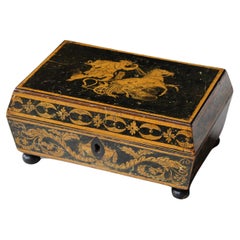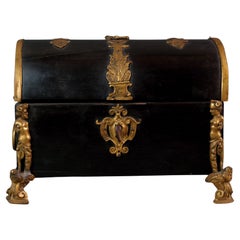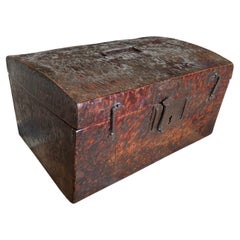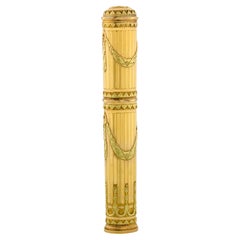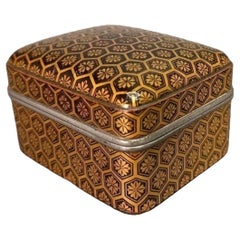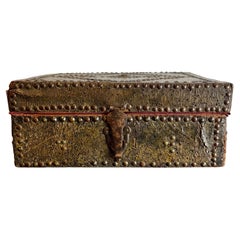18th Century and Earlier Decorative Boxes
to
46
409
409
2,214
4,428
1,032
1,116
1,549
1,053
187
87
186
225
105
219
356
525
198
68
66
48
18
10
9
8
5
3
3
2
1
268
164
42
34
33
208
185
313
94
78
61
61
Height
to
Width
to
409
409
409
3
3
1
1
1
Period: 18th Century and Earlier
Late 18th Century Neoclassical George III Penwork Sarcophagus Jewellery Box
Located in Lowestoft, GB
A George III penwork sarcophagus work box with hinged lid decorated with a chariot, the side with Neo-Classical devices.
Age related abrasions and knocks later replacement ebonised ...
Category
European Neoclassical Antique 18th Century and Earlier Decorative Boxes
Materials
Sycamore
Early 17th Italian Renaissance Box Set Ebony, Gilded Bronze and Gemstones
Located in Pistoia, IT
Rare and valuable ebony-plated domed case with rich gilt bronze decoration and central jasper medallion.
Italian Renaissance manufacture from the early 17th century.
The production...
Category
Italian Renaissance Antique 18th Century and Earlier Decorative Boxes
Materials
Bronze
French 17th Century Leather Box, Coffre
Located in Round Top, TX
A very charming late 17th century French Coffre - Box crafted from beautifully patina'd leather. A wonderful piece to serve as a jewelry box or to adorn any table top.
Category
French Antique 18th Century and Earlier Decorative Boxes
Materials
Leather
Gold Étui in Original Case
Located in New Orleans, LA
Gold Étui in Original Case
Jacques Martin Petitjean
Circa 1777
Expertly engraved entirely of yellow gold, this remarkably rare Louis XVI-era étui is a work of art. Resplendent colum...
Category
French Louis XVI Antique 18th Century and Earlier Decorative Boxes
Materials
Gold
$20,220
A Japanese Edo Period Lacquer Kogo (Incense) Box, late 17/early 18th Century
Located in Spencertown, NY
Early Japanese Lacquer Incense Box (Kogo) Late 17thc. Of rectangular form with soft corners, decorated with a diaper pattern in gold lacquer on a brownish black ground, with pewter r...
Category
Japanese Edo Antique 18th Century and Earlier Decorative Boxes
Materials
Pewter
French Louis XIV Messenger Box - Leather Wrapped Wood - France - 17th 18th
Located in Beuzevillette, FR
Magnificent Louis XIV period messenger box, late 17th and early 18th centuries.
This pretty box is made of leather-covered wood decorated with copper nails forming diamonds on the to...
Category
French Louis XIV Antique 18th Century and Earlier Decorative Boxes
Materials
Leather, Wood
$906 Sale Price
20% Off
Antique Japanese Ink Stone Maki-e Lacquer Box Suzuribako Edo Provenance
Located in Atlanta, GA
A Japanese ink stone box (known as Suzuribako) with exquisite maki-e decoration from Edo period (circa mid-18th century). The box features a rectang...
Category
Japanese Edo Antique 18th Century and Earlier Decorative Boxes
Materials
Wood, Lacquer
Chinese Picnic Box, c. 1750
Located in Chicago, IL
The basic form of this two-tiered box with handle has remained unchanged for 1,000 years. Stacked boxes were commonly used as portable containers for food or ...
Category
Chinese Qing Antique 18th Century and Earlier Decorative Boxes
Materials
Hardwood
$57,280
16th Wrought Iron Safe, Renaissance Style, for Donations or Cash Chest
Located in Marbella, ES
Impressive wrought iron tabletop safe with engraved decoration and original patina. This type of safe was commonly used in the 16th and 17th centuries to hold valuables, alms, or doc...
Category
Spanish Antique 18th Century and Earlier Decorative Boxes
Materials
Iron
Embriachi workshop marquetry casket - Northern Italy, 15th century
Located in Bruxelles, BE
Embriachi workshop marquetry casket
Northern Italy, 15th century
Alla certosina inlays (bone, stained bone, pewter and wood)
H 28.2 x W 18 x D 14 cm
This beautiful casket of rectangular form is richly decorated with the characteristic geometric patterns of the Embriachi style.
The intricate geometric patterns are fashioned by juxtaposing lighter and darker pieces of wood, (colored) bone, horn and pewter. The lid and base are framed by a broad band of horn. When ivory became scarce in Europe due to disrupted trade routes, bone was substituted.
The attention to Symmetry and balance created an harmonious visual effect
Enhancing the overall aesthetic appeal of the casket.
The application of geometrical motifs is in Italy known as marquetry ‘alla Certosina’, named after the Certosina Church in Pavia with its famous altarpiece decorated in this way. This is ‘intarsia technique’, a term derived from the Arabic 'tarsi', which means ‘incrustation' recalling ancient mosaics made from various materials.
These geometric elements not only enhance the aesthetic appeal of the caskets but also demonstrate the versatility and skill of the artisans in creating multifaceted works of art.
‘Alla Certosina’ became famous through the Northern Italian Embriachi family who achieved a particularly high standard in working in this technique. Venice in particular was known for the production of these luxurious boxes. The caskets, hexagonal or rectangular, surmounted by a lid decorated in several registers constitute the secular, albeit equally renowned component of the workshop’s production, in addition to mirror frames and various everyday objects.
The method of fabrication of those objects was based on two concepts that underlay pre-industrial production: standardization and modularity, thanks to a distribution of skills according to the different phases of fabrication.
even the realization of the marquetry motifs (in the form of ingots from which portions of the desired size were cut) were therefore entrusted to various specialized craftsmen, as were the assembly phase.
Today better known thanks to the extensive research work recently carried out by Michele Tomasi, this workshop owes its name to its founder and owner, the Florentine Baldassare Ubriachi (or degli Embriachi), a merchant and banker established in the Tuscan capital before he settled in Venice in 1395. Together with sculptor Giovanni di Jacopo, who directed the workshop, from the last years of the fourteenth century, Baldassare oversaw a production that was truly original, and still easily recognizable today, comprising monumental altarpieces and various objects, primarily triptychs and caskets.
The precise location of the workshop is unknown, except that it originated in Florence and in ca. 1431 there was apparently a workshop in Venice, in the area of S Luca. They employed local workers specializing in 'certosina' (inlay of stained woods, bone and horn), and the workshop produced items carved in bone (usually horse or ox) with wood and bone marquetry.
The geometric decoration of Embriachi caskets reflects the artistic complexity and attention to detail that characterized their work.
this inlaid casket is a testament to the skill and artistry of the Embriachi family and serves as a stunning example of the decorative arts of the late Middle Ages.
Related Literature :
E. Berger, Prunk-Kassetten: Europäischen Meisterwerke aus acht Jahrhunderten / Ornamental Caskets...
Category
Italian Renaissance Antique 18th Century and Earlier Decorative Boxes
Materials
Pewter
$20,271 Sale Price
22% Off
Cherry wood and native wood box from the 18th century
Located in Beuzevillette, FR
Very large slurry box with parts in native wood veneer, marquetry nets and geometric decorations in marquetry on the top. The box rests on four arched feet in the Louis XV style.
Thi...
Category
French Louis XV Antique 18th Century and Earlier Decorative Boxes
Materials
Wood
$1,526 Sale Price
20% Off
Late 17th Century Leather And Brass Travelling Box
Located in Benington, Herts
A very fine and interesting late 17th century English work box or travelling case
English Circa 1680
Of conventional form with slightly domed lid, this piece has acquired a magnifi...
Category
English Antique 18th Century and Earlier Decorative Boxes
Materials
Brass
18th Century, Lowestoft English Porcelain Trinket Box
Located in Hamilton, Ontario
18th century, English porcelain trinket box hand decorated in polychrome glazes and inscribed: "A Trifle from Lowestoft 1795".
Category
English George III Antique 18th Century and Earlier Decorative Boxes
Materials
Porcelain
$3,195 Sale Price
54% Off
Petite Ming Shipwreck Box, c. 1500
Located in Chicago, IL
The soft, matte texture and eroded wear of this petite porcelain box suggest the it spent many years submerged in saltwater, likely excavated from a sunken trade ship carrying cerami...
Category
Chinese Ming Antique 18th Century and Earlier Decorative Boxes
Materials
Porcelain
An Italian Gold Embossed Leather Knife Box, 18th Century
Located in ARMADALE, VIC
An Italian Gold Embossed Leather Knife Box, 18th Century
Description:
The wooden surface with leather overlay and painted gilt surface decoration consisting of florets and a central...
Category
Italian Antique 18th Century and Earlier Decorative Boxes
Materials
Leather, Wood
George III Parcel Gilt and Gold Neo Classical Aide Memoire, circa 1775
Located in London, GB
A Very Rare George III Parcel Gilt and Gold Neo Classical Aide Memoire Made Most Probably in London circa 1775. Does Not Contain Ivory.
This very rare parcel gilt Aide Memoire has a...
Category
English George III Antique 18th Century and Earlier Decorative Boxes
Materials
Silver
Petite Ming Shipwreck Box, c. 1500
Located in Chicago, IL
The soft, matte texture and eroded wear of this petite porcelain box suggest the it spent many years submerged in saltwater, likely excavated from a sunken trade ship carrying cerami...
Category
Chinese Ming Antique 18th Century and Earlier Decorative Boxes
Materials
Porcelain
Antique Japanese Lacquer and Inlay Box from Ryukyu Island
Located in Atlanta, GA
A lacquer presentation box with mother-of-pearl inlays from Japanese Ryukyu Islands circa 17-18th century. The lidded box in rectangular form with rounded corner is a classic example...
Category
Japanese Japonisme Antique 18th Century and Earlier Decorative Boxes
Materials
Mother-of-Pearl, Lacquer
19th Century French Porcelain and Brass Trinket Box with Flower Decorations
Located in Marbella, ES
19th century French porcelain and brass trinket box with flower decorations.
Category
French Antique 18th Century and Earlier Decorative Boxes
Materials
Porcelain
Cute Table Top Italian Early 18th Century Walnut Chest w/Drawers
Located in Atlanta, GA
A small sized Italian walnut chest from the early 18th century. This Italian chest of four drawers features carved column side posts, paneled drawers and sides and sits atop four pet...
Category
Italian Antique 18th Century and Earlier Decorative Boxes
Materials
Wood, Walnut
17th Century Figured Walnut and Seaweed Marquetry Lace Box
Located in Oxfordshire, United Kingdom
A fine and extremely rare figured walnut and seaweed marquetry 'lace box', circa.... let’s break it down - Seaweed marquetry first appeared in Englis...
Category
English Baroque Antique 18th Century and Earlier Decorative Boxes
Materials
Walnut
18th Century Swedish Wedding Box
Located in Houston, TX
This late 18th-century Swedish wooden box exudes rustic charm and historical character. Crafted in Sweden during the waning years of the 18th century, this antique treasure showcases...
Category
Swedish Rustic Antique 18th Century and Earlier Decorative Boxes
Materials
Metal
French Original Black Painted Portable 18th Century Writing Desk
Located in Haddonfield, NJ
An original black painted portable desk from the end of the 18th century. With owner initials, the desk has a French hand-written address on the inside. ...
Category
French Louis XVI Antique 18th Century and Earlier Decorative Boxes
Materials
Wood
Petite Ming Shipwreck Box, c. 1500
Located in Chicago, IL
The soft, matte texture and eroded wear of this petite porcelain box suggest it spent many years submerged in saltwater, likely excavated from a sunken trade ship carrying ceramic ex...
Category
Chinese Ming Antique 18th Century and Earlier Decorative Boxes
Materials
Porcelain
18th Century English Early Georgian Mahogany Box with Original Handles
Located in Atlanta, GA
An early Georgian mahogany box from the late 18th century. This exquisite English box is made of a rich mahogany wood seemingly stained to perfec...
Category
English Georgian Antique 18th Century and Earlier Decorative Boxes
Materials
Bronze
Hispano-Moresque Mudéjar Bone-Inlaid Walnut Chest
- Spain, 16th century
Located in Bruxelles, BE
Hispano-Moresque Mudéjar Bone-Inlaid Walnut Chest
Spain, 16th–17th century
Walnut, bone inlay, iron fittings
44.5 × 30.5 × 18 cm
This rectangular walnut chest, richly ornamented ...
Category
Spanish Renaissance Antique 18th Century and Earlier Decorative Boxes
Materials
Bone, Walnut
Meissen Gilt-Metal Mounted Etui / Bodkin Case, circa 1755
Located in Basildon, GB
Meissen Gilt-Metal Mounted Etui / Bodkin Case, circa 1755, cylindrical case painted with floral trails between blue-scale borders, the ends painted with pe...
Category
German Rococo Antique 18th Century and Earlier Decorative Boxes
Materials
Porcelain
German Porcelain Box
Located in New Orleans, LA
This important German porcelain box exhibits delightful artistry and craftsmanship. Its hand-painted wild game scene celebrates the natural world,...
Category
German Antique 18th Century and Earlier Decorative Boxes
Materials
Gold, Bronze
$3,950
Antique Japanese Lacquered Incense Box Kobako Ex-Christie's
Located in Atlanta, GA
An old Japanese lacquered small box likely used to contain incense powder called Kobako, circa Momoyama to early Edo period (16-17th century). The rectangular form box with a fitted ...
Category
Japanese Japonisme Antique 18th Century and Earlier Decorative Boxes
Materials
Lead
Fine Large Example Of A Kingwood Oyster Veneer Coffre Fort
Located in Lincolnshire, GB
A superb early 18th century kingwood oyster veneered coffre fort with fine gilt brass metal work, the fall front opens to reveal three drawers and three hidden compartments.
Lovely c...
Category
European Antique 18th Century and Earlier Decorative Boxes
Materials
Brass
Late 18th Century Oak Box with Faux Drawers, Handles and Carved Scrolls
Located in Atlanta, GA
An English oak blanket chest from the late 18th century, with faux drawers and carved scrolls. Created in England during the later years of the 18th century, this oak blanket chest f...
Category
English Antique 18th Century and Earlier Decorative Boxes
Materials
Brass
17th Century Cutlery Box
Located in Vosselaar, BE
A 17th century cutlery box with the original leather, metal hardware and interior.
Category
French Antique 18th Century and Earlier Decorative Boxes
Materials
Leather, Softwood
$1,430
C1680 Oak Bible Box Well Carved
Located in Bakewell, GB
C1680 oak bible box well carved on 3 sides
good colour and patination
58cms Wide x 45cms Deep x 24cms High
Category
Antique 18th Century and Earlier Decorative Boxes
Materials
Oak
RARE IBERIAN SAFE from the first half of the 17th Century
Located in Madrid, ES
RARE IBERIAN SAFE
from the first half of the 17th Century
in painted and gilded carved wood decorated with plant motifs.
Small defects. Dim.: 34 x 43 x 35 cm
Category
Portuguese Baroque Antique 18th Century and Earlier Decorative Boxes
Materials
Wood
Moorish Incense Burner from Spain, Dated to 10th-12th Century
Located in London, GB
Moorish incense burner from Spain, dated to 10th-12th century
Spanish, 10th-12th century
Measures: Burner height 20cm, width 12cm, depth 12cm
Box height 23cm, width 21cm, depth 18...
Category
Spanish Moorish Antique 18th Century and Earlier Decorative Boxes
Materials
Bronze
Flemish Ebony and kingwood Table Cabinet
Located in Lincolnshire, GB
A charming 17th century ebony and kingwood cabinet with turned columns to the corners, the fall front opens to reveal a set of drawers and arched mirrored centre. The lid also housin...
Category
European Antique 18th Century and Earlier Decorative Boxes
Materials
Ebony, Kingwood
Yellow Lacca Povera Box
Located in New York, NY
Yellow lacca povera box. Late 17th century chest with early 19th century lacca povera decalcomania decorations with angels, birds, lions, flowers, and trees; with original hardware a...
Category
Italian Baroque Antique 18th Century and Earlier Decorative Boxes
Materials
Wood, Paper
$5,500
18th Century Oak French Silver Chest Strongbox
Located in Buisson, FR
Beautiful handmade oak silver chest. It was made to hold valuables such as silver coins, jewels or maps. This was the precursor to the modern day safe. It is due to its age beautiful...
Category
French Primitive Antique 18th Century and Earlier Decorative Boxes
Materials
Iron
$1,371 Sale Price
49% Off
A Georgian Estate Made Letterbox
Located in London, GB
A most charming estate made country house letter box with delicately inlaid LETTER BOX to front.
English, George III
H 27 x W 23 x D 15 cms
Category
British George III Antique 18th Century and Earlier Decorative Boxes
Materials
Mahogany
18th C. Venetian Italian Wood Box w/its Original Finish, 26.5" Wide
Located in Atlanta, GA
A Venetian Italian box with its original finish, from the 18th century. This antique wood box from Italy is rectangular in shape with a raised foliate...
Category
Italian Antique 18th Century and Earlier Decorative Boxes
Materials
Wood
Chest. Carved wood, metal. Spanish school, 16th century.
Located in Madrid, ES
Chest. Carved wood, metal. Spanish school, 16th century.
Rectangular casket with a flat lid decorated on the outside with a series of figurative reliefs in a symmetrical arrangemen...
Category
Spanish Renaissance Antique 18th Century and Earlier Decorative Boxes
Materials
Metal, Other
England 1780 Georgian Battersea Enamel Baroque Decorated Box in Gilded Bronze
Located in Miami, FL
Late 18th century Georgian Battersea enamel box.
A beautiful antique English Battersea Bilston table snuff box, created in the district of Bat...
Category
English George III Antique 18th Century and Earlier Decorative Boxes
Materials
Bronze, Enamel
$2,388 Sale Price
20% Off
Rare George II Pagoda Form Mahogany Cellarette or Caddy
Located in Milford, NH
A rare English George II cellarette in the form of a pagoda, with removable top with brass acanthus knop or finial, side handles, and liner, as well as two drawers, and all raised on...
Category
English George II Antique 18th Century and Earlier Decorative Boxes
Materials
Brass
Early 18th Century Italian Carved and Dovetailed Walnut Alms Box
Located in San Francisco, CA
Early 18th century Italian carved and dovetailed walnut alms box, circa 1725
Large dovetails and old handwrought nails give this small scale box a hea...
Category
Italian Baroque Antique 18th Century and Earlier Decorative Boxes
Materials
Iron
Important and Rare Italian Box Safe from the 17th Century '1647'
Located in Madrid, ES
Important and Rare Italian box safe from the 17th century
In chiseled bronze, decorated with jasper plates and hard stones, with a cameo with a male figure at the centre.
Inscriptio...
Category
Italian Baroque Antique 18th Century and Earlier Decorative Boxes
Materials
Bronze
Wrought iron box with secret 18th century
Located in Madrid, ES
Wrought iron box with secret 18th century
Riveted wrought iron box. One of the rivets moves upwards and makes an internal mechanism move in order to open. The mechanism is incomplete...
Category
Antique 18th Century and Earlier Decorative Boxes
Materials
Wrought Iron
Early 18th Century Inlaid Italian Walnut and Tortoise Shell Vargueno
Located in Richmond, VA
Early 18th century inlaid Italian walnut and tortoiseshell vargueno. 6 drawers with fine inlay, iron hardware.
Category
Italian Antique 18th Century and Earlier Decorative Boxes
Materials
Iron
Boiled Leather Trunk, Spanish, 17th Century
Located in Bruxelles, BE
Leather trunk
Spanish, 17th century
Boiled Leather, wood and iron
Measures: 22 x 53 x 32 cm.
Provenance :
- collection Metz-Noblat, Château de Clevant, France
Rectangular trunk of the form and size of a small suitcase with wrought iron hinges and lock-plate.
Wood, covered with leather, cut and embossed with every surface of the thick cow hide covered in interlace, zoomorphic features.
The construction method is boiled leather, often referred to by its French translation cuir-bouilli: a process used to change flexible, vegetable-tanned leather into rigid, moulded objects. For shaping of the vegetable-tanned leather, heat and moisture were used, as indicated by the term boiled leather. No written medieval sources describing the production of decorated cuir bouilli objects survive, so knowledge of the process relies on the important studies of the Scottish leather historian John William Waterer. A large range of methods, materials and techniques could be used in various combinations. The vegetable-tanned leather, made supple with moisture and heat, was stuffed, shaped and nailed to the rigid wooden coffer support. The stuffing material was probably modeled beeswax or stearin wax. To shape the leather, to create its topography, « Cushions » were made by lacing a thread through an awl hole and attaching the flexible leather and stuffing to the rigid wooden support on the bottom. Then the decoration was done: lines were incised through the upper layer of the leather (epidermis) with different thicknesses of knives or needles. Contours were created with deep v-shaped cuts, decoration with thin incision and final details with a needle point. For the incision and pouncing stage, the leather was probably kept heated and moistened for suppleness.
Once dry, the leather would be hard and rigid.
the saturated leather is worked over a form, possibly even damp sand, with the pattern shaped using bone or wooden tools. Compare to metal, leather was lighter and it offered protection from cuts and punctures. Cuir bouilli objects were produced by specialist leather workers and needed skillful craftsmanship.
The surface is filled with roundels shaped foliages enclosing animals, lions and peacocks. The foliate arabesques creating a vegetal connection tweet the animals create the impression of a lush verdant space . The vegetal pattern here employed in combination with geometrical pattern came from the pre-islamic artistic traditions of the Byzantine and Sasanian empires. An aspect of Islamic geometry Is the basic symmetrical repetition and mirroring of the shapes that create a sense of harmony.
The decoration of this truck is inspired by the islamic « arabesque » a form of vegetal ornament composed of spirals, intertwining plants and abstract curvilinear motifs. An arabesque character is given to the birds of the decorations through extreme stylisation. This arabesque maintained the classical tradition of median symmetry, freedom in Detail and heterogeneity of ornament.
The presence of the peacocks is a paradisiacal allusion: in popular Islamic literature they were among the original inhabitants of the garden of Paradise expelled with Adam and Eve. Peacock as a decorative motif may have originated in the West, despite their eastern provenance. There was an ancient belief that the flesh and feathers of peacock do not decay. This led to the peacock becoming a christian symbol for Christ’s resurrection.
Renowned for their decorative wall hangings, seventeenth-century Spanish leatherworkers also produced utilitarian objects, such as this trunk. A similar trunk is on display at the Metropolitan museum of art ( 09.158.1).
Related literature :
Davies L. 2006. Cuir bouilli. Conservation of leather and related materials, 94-102, Oxford: elsevier Butterworth-Heinemann
Grabar, Oleg. The Mediation of Ornament. Princeton: Princeton University Press, 1992
Gabriela Germana Roquez, "El mueble en el Peru en el siglo XVIII...
Category
Antique 18th Century and Earlier Decorative Boxes
Materials
Iron
$12,878 Sale Price
40% Off
Mexican Tortoiseshell and Pen-Engraved Cabinet
Located in Mexico, DF
Mexican cabinet. Made of tortoiseshell, pen-engraved and wood. Possible Oaxaca or Puebla, 17th century.
Category
North American Spanish Colonial Antique 18th Century and Earlier Decorative Boxes
Materials
Tortoise Shell
Antique English Mahogany Georgian Double Tea Caddy attrib Gillows 18th Century
Located in Dublin, Ireland
A Superb Example of an English Georgian Period Well figured Mahogany Double Interior Section Tea Caddy of flat rectangular outline, generous proportions and outstanding quality, all ...
Category
English Georgian Antique 18th Century and Earlier Decorative Boxes
Materials
Mahogany
English 18th Century Gold-Mounted Agate Snuff-Box
Located in Paris, FR
Agate box or snuff-box in of circular form with gently bombé sides, the gold mounted lid is chased with scrollwork.
Probably Georges II period.
Unmarked gold...
Category
English George II Antique 18th Century and Earlier Decorative Boxes
Materials
Agate, Gold
Early 18th Century Italian Baroque Carved Walnut Dome-Top Box
Located in Troy, NY
Early 18th Century Italian Baroque Carved Walnut Dome-Top Box. Unusual carved box with a dome top cover and one-drawer.
Nice dried out light color.
Category
Italian Baroque Antique 18th Century and Earlier Decorative Boxes
Materials
Walnut
Antique 18th Century Bilston Battersea Enamel Muffineer or Sugar Shaker
Located in Philadelphia, PA
An antique 18th century Bilston or Battersea enamel muffineer or sugar shaker.
A very rare form!
With a pierced, domed top, raised gold decoration, and cartouches of floral spr...
Category
British George II Antique 18th Century and Earlier Decorative Boxes
Materials
Enamel
17th Century, Italian Wooden Box Coated in Engraved Leather
Located in Firenze, FI
Wooden box lined with leather engraved with damask motifs, studded with convex bronze nails. This casket was used by placing it on the altars of the family chapels to house the candl...
Category
Italian Antique 18th Century and Earlier Decorative Boxes
Materials
Leather, Wood
Composition of red tortoiseshell gold piqué-work box, 18th century
Located in Paris, FR
Circular box in composition of red tortoiseshell powder called "Indian red". Inlays of nets in the form of waves of different shades of gold (rose gold and white) run across the lid...
Category
French Louis XV Antique 18th Century and Earlier Decorative Boxes
Materials
Gold
19th Century Anglo-Indian Hand Carved Tropical Wood Box
Located in Marbella, ES
19th century Anglo-Indian hand carved tropical wood box.
Category
Indian Antique 18th Century and Earlier Decorative Boxes
Materials
Fruitwood
Antique Charles II Oak Bible Box with Carved Facade c. 1660-1685
Located in Westfield, MA
This Antique Charles II Oak Bible Box, dating from c. 1660-1685, is a remarkable piece of early English furniture, showcasing the detailed craftsmanship and design aesthetics of the ...
Category
English Charles II Antique 18th Century and Earlier Decorative Boxes
Materials
Oak
Two Annamese Covered Boxes with Bird and Plant Motif, 15th century, Le Dynasty
Located in seoul, KR
Vietnamese covered boxes with representative bird and plant designs. Both are made of cream-colored base and blue designs, typical of Annamese pottery. These shared characteristics h...
Category
Vietnamese Antique 18th Century and Earlier Decorative Boxes
Materials
Ceramic, Stoneware
Mid 17th Century Dutch Engraved Silver Wedding Casket or knottekist, Circa 1660
Located in Oxfordshire, United Kingdom
A museum-grade mid-17th century Dutch silver marriage casket or knottekistje, circa 1660.
Raised on solid silver bun feet the miniature casket is profusely engraved to all faces depicting a courting couple and architecture entwined in scrolling foliage. The reverse of the casket depicts the last supper, however, if you look closely, you can see a boy stealing food or wine from underneath! Possibly, this is the courting gentleman showing that he had a sense of humour.
The scratch lined moulded top is surmounted with an intricate handle (once gilt) and floral patera to the centre. There are two inscriptions each within a cartouche 'In Lÿfde Beltact het al' and 'Getrouw tot in den doot' which loosely translates to 'faithful until the death' and 'love is everything'.
Wedding caskets...
Category
Dutch Baroque Antique 18th Century and Earlier Decorative Boxes
Materials
Silver
1750 Venezia Italy Rococo Lacquered Wooden Yellow Box and Jewelry Case
Located in Brescia, IT
This is a magnificent lacquered wooden box, with rich polychrome decoration on a yellow background.
In the center of the lid an exotic landscape has been painted with palm, flowers and berries surrounding the figure of the elegant dressed lady.
The box has done following the techinque of "arte povera". With this tecnique there are less layers of lacquer and the decoration is made with a paper collage together some lacquered parts.
This brighting piece hails from the Mid-18th Century in Venezia and masterfully shows the lacquered Venetian style.
This box has a timeless beauty and it is a little jewel to contain jewels.
One of the distinctive characteristics of Venetian Baroque and Rococo furniture and decorative objects is the skilful use of lacquers. Lacquer is a natural resin that was very rare in the past, imported from the East and used to create smooth and colored surfaces on furniture, ready to be finely decorated with refined floral designs or exotic animals.
Venetian artisans became masters in lacquer processing which required time and patience because it was made with many steps.
The Venetian style deeply influenced furniture design throughout Europe, but none reached the Venetian level in terms of beauty. The skillful use of lacquer and carvings defined Venice's unique style during the Rococo period, its Golden Age.
The piece is in very good state of maintenance and it is guaranteed original in every parts. The surface was only cleaned not restored and it is original. The little iron key is not working.
The wooden yellow lacquered box...
Category
Italian Rococo Antique 18th Century and Earlier Decorative Boxes
Materials
Wood, Lacquer
